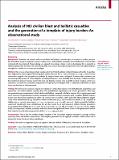Files in this item
Analysis of 983 civilian blast and ballistic casualties and the generation of a template of injury burden : an observational study
Item metadata
| dc.contributor.author | Maitland, Laura Mary Rose | |
| dc.contributor.author | Middleton, Lawrence | |
| dc.contributor.author | Veen, Harald | |
| dc.contributor.author | Harrison, David James | |
| dc.contributor.author | Baden, James | |
| dc.contributor.author | Hettiaratchy, Shehan | |
| dc.date.accessioned | 2022-09-30T09:30:18Z | |
| dc.date.available | 2022-09-30T09:30:18Z | |
| dc.date.issued | 2022-12-01 | |
| dc.identifier | 281537883 | |
| dc.identifier | f254d878-69bb-417b-80b7-726253689ffa | |
| dc.identifier | 85139050023 | |
| dc.identifier | 000886539400019 | |
| dc.identifier.citation | Maitland , L M R , Middleton , L , Veen , H , Harrison , D J , Baden , J & Hettiaratchy , S 2022 , ' Analysis of 983 civilian blast and ballistic casualties and the generation of a template of injury burden : an observational study ' , EClinicalMedicine , vol. 54 , 101676 . https://doi.org/10.1016/j.eclinm.2022.101676 | en |
| dc.identifier.issn | 2589-5370 | |
| dc.identifier.other | ORCID: /0000-0001-9041-9988/work/120051545 | |
| dc.identifier.uri | https://hdl.handle.net/10023/26106 | |
| dc.description | Funding: The work was supported in part by a grant to LM from School of Medicine, University of St Andrews. | en |
| dc.description.abstract | Background Terrorism and armed conflict cause blast and ballistic casualties that are unusual in civilian practice. The immediate surgical response to mass casualty events, with civilians injured by these mechanisms, has not been systematically characterised. Standardising an approach to reacting to these events is challenging but is essential to optimise preparation for them. We aimed to quantify and assesses the surgical response to blast and ballistic injuries managed in a world-class trauma unit paradigm. Methods This was an observational study conducted at the UK-led military Medical Treatment Facility, Camp Bastion, Afghanistan from original theatre log-book entries between Nov 5, 2009, and Sept 21, 2014; a total of 10,891 consecutive surgical cases prospectively gathered by surgical teams were catalogued. Patients with combatant status/wearing body-armour to various degrees including interpreters were excluded from the study. Civilian casualties that underwent primary trauma surgery for blast and ballistic injuries were included (n=983). Surgical activity was analysed as a rate per 100 casualties, and patients were grouped according to adult vs. paediatric and ballistic vs. blast injury mechanisms to aid comparison. Findings The three most common surgical procedures for civilian blast injuries were debridement, amputation, and laparotomy. For civilian ballistic injuries, these were debridement, laparotomy and vascular procedures. Blast injuries generated more amputations in both adults and children compared to ballistic injuries. Blast injuries generated more removal of fragmentation material compared to ballistics injuries amongst adult casualties. Ballistic injuries lead to more chest drain insertions in adults. As a rate per 100 casualties, adults injured by blast underwent significantly more debridement (63·5); temporary skeletal stabilisation (13·2) and vascular procedures (12·8) compared to children (43·4, z=4·026, p=0·00007; 5·7, z=2·230, p=0·022; 4·9, z=2·468, p=0·014). Adults injured by ballistics underwent significantly more debridement (63·4); chest drain (12·3) and temporary skeletal fixation procedures (11·4) compared to children (50·0, z=2·058, p=0.040, p<0·05; 2·9, z=2·283, p=0.0230; 2·9, z=2·131, p=0.034 respectively). By comparison, children injured by ballistics underwent significantly more removal of fragmentation and ballistic materials (20·6) when compared to adults (7·7, z=−3·234; p=0.001). Interpretation This is the first evidence-based, template of the immediate response required to manage civilians injured by blast and ballistic mechanisms. The template presented can be applied to similar conflict zones and to prepare for terror attacks on urban populations. | |
| dc.format.extent | 12 | |
| dc.format.extent | 901188 | |
| dc.language.iso | eng | |
| dc.relation.ispartof | EClinicalMedicine | en |
| dc.subject | Civilian | en |
| dc.subject | Blast | en |
| dc.subject | Ballistic | en |
| dc.subject | Trauma | en |
| dc.subject | Surgery | en |
| dc.subject | Explosion | en |
| dc.subject | Treatment | en |
| dc.subject | War | en |
| dc.subject | Terror attack | en |
| dc.subject | Template | en |
| dc.subject | Injury | en |
| dc.subject | HV Social pathology. Social and public welfare | en |
| dc.subject | RC Internal medicine | en |
| dc.subject | RD Surgery | en |
| dc.subject | NDAS | en |
| dc.subject | SDG 16 - Peace, Justice and Strong Institutions | en |
| dc.subject | MCC | en |
| dc.subject.lcc | HV | en |
| dc.subject.lcc | RC | en |
| dc.subject.lcc | RD | en |
| dc.title | Analysis of 983 civilian blast and ballistic casualties and the generation of a template of injury burden : an observational study | en |
| dc.type | Journal article | en |
| dc.contributor.institution | University of St Andrews. Sir James Mackenzie Institute for Early Diagnosis | en |
| dc.contributor.institution | University of St Andrews. Cellular Medicine Division | en |
| dc.contributor.institution | University of St Andrews. School of Medicine | en |
| dc.identifier.doi | https://doi.org/10.1016/j.eclinm.2022.101676 | |
| dc.description.status | Peer reviewed | en |
This item appears in the following Collection(s)
Items in the St Andrews Research Repository are protected by copyright, with all rights reserved, unless otherwise indicated.

